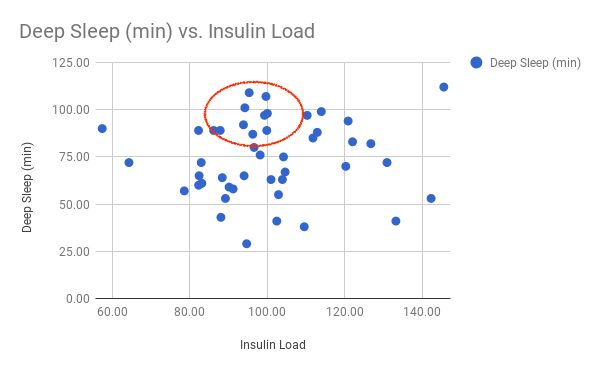Biohacking: Using Insulin Load for Better Sleep and Recovery
An interesting chart popped recently popped up in Facebook Ouraring-Users group. The chart provided by Chuck Hazzard (an Oura Ring employee) used the HeadsUpHealth Service to generate a graph. Chuck used the HRV data (Heart Rate Variability) from his Oura Ring and compared it with insulin load levels from MyFitnessPal food logging. The results show how our HRV (which translates into readiness) can be influenced by carbs and protein.
In a world with year-round plentiful sugars biohackers tend to get hung up on counting carbohydrates when dieting. It is important to remember that while protein is essential it can be easily converted to sugars. Our liver is more than happy to take up to 56% of the protein we eat and convert it over to glucose. There is a simple equation we can use to calculate our “insulin load”:
Insulin Load = Carbohydrates (g) – Fiber (g) + [.56 x Protein (g)]
The above formula suggests that if we limit carbs and protein and boost fiber we could reduce our insulin load. This provides an entirely different way of looking at meals. Someone on a low carb diet might consider three eggs to be less likely to cause an insulin response than a serving of almond butter with macadamia nuts.
Let’s compare the two:
3 Hard Boiled Eggs (150g)NetCarbs = 2.8gProtein = 17.7gInsulin Load = 2.8g + [.56 * 17.7]Insulin Load = 12.7Almond Butter (2 Tbl) + Macadamia Nuts (1oz)NetCarbs = 4.1gProtein = 8.8gInsulin Load = 4.1g + [ .56 * 8.8 ]Insulin Load = 9
| Avg Insulin Load: | 97.40 |
| Avg Net Carbs: | 42.09 |
| Low Net Carbs: | 17.67 |
| High Net Carbs: | 69.53 |
| Min Insulin Load: | 46.21 |
| Max Insulin Load: | 145.56 |
Comparing Insulin Load with Biometrics
The insulin load formula has the potential to help us optimize our wellbeing. Using more #quantifiedself collected data we can look for the following metrics compared to insulin load. These charts were produced from data exported through cronometer and graphed with google sheets.
- deep sleep
- REM sleep
- recovery (HRV)
- recovery (RHR)
- blood glucose
- blood ketones
I’ve generated a few scatter plots below suggesting that there are “sweet spots” to hold our insulin load out for better health. These data provided is specific to me and could well be significantly different for others.
- Deep Sleep vs Insulin Load – optimal IL range – [ 95 – 100 ]
- REM Sleep vs. Insulin Load – More REM is better – optimal IL range [ 90 – 120 ]
- HRV vs Insulin Load – A Higher Heart Rate Variability is a sign of recovery – optimal IL range [ 80 – 120 ]
- Resting Heart Rate (RHR) vs Insulin Load – A lower resting heart rate is better – optimal IL range [ 80 – 110 ]
- Blood Glucose vs. Insulin Load – A lower blood glucose levels is better – optimal IL range [ 75 – 115 ]
- Blood Ketone vs. Insulin Load – A higher ketone reading is better – optimal IL range [ 75 – 115 ]







